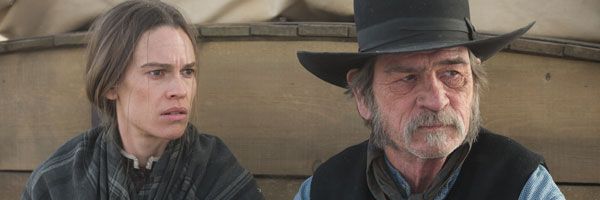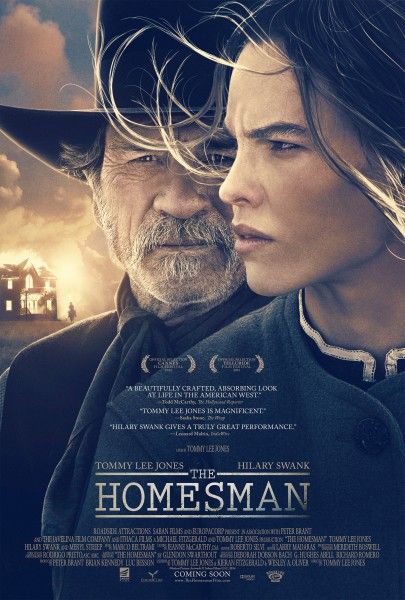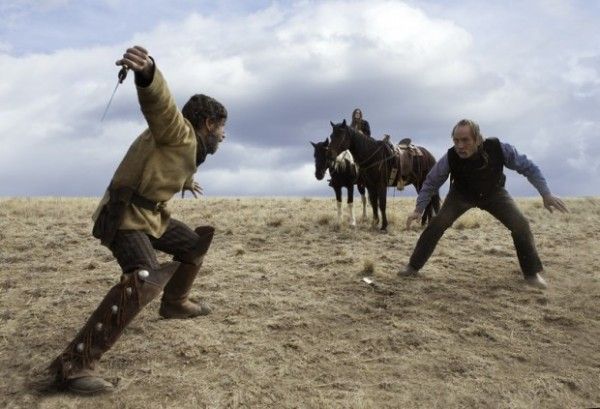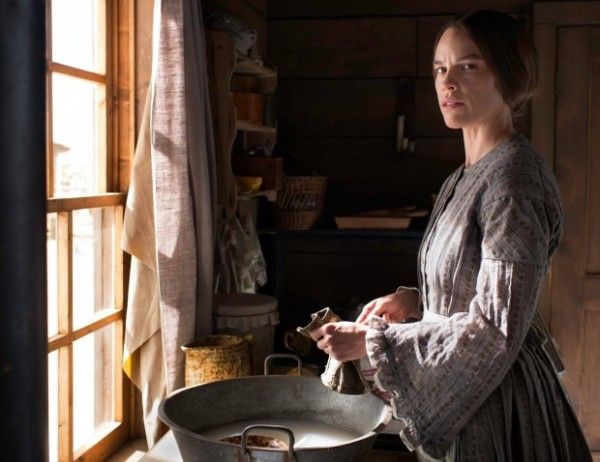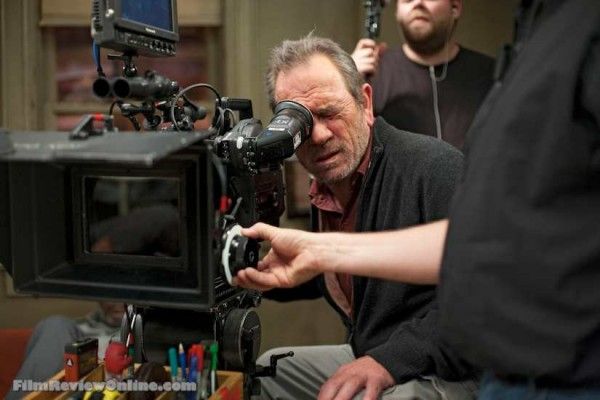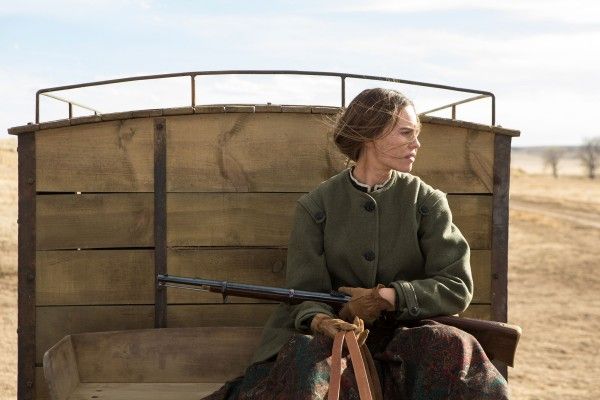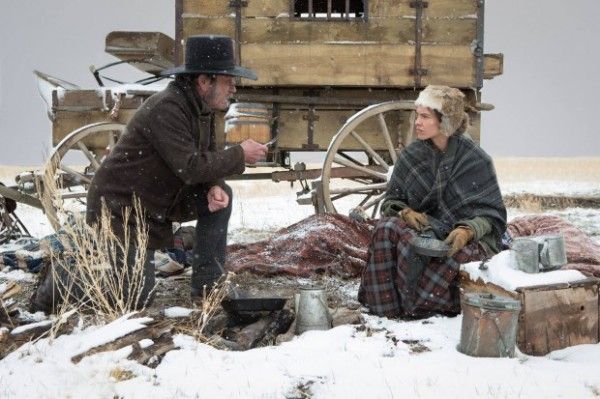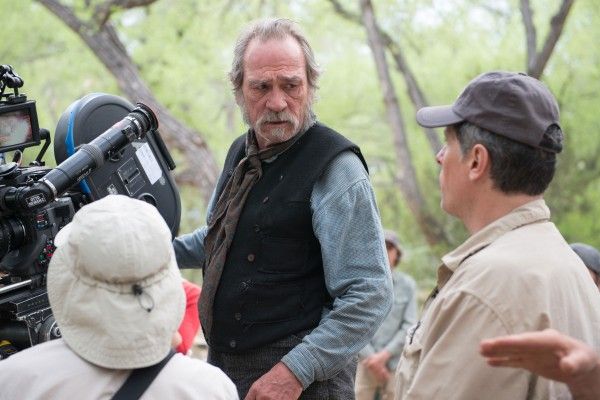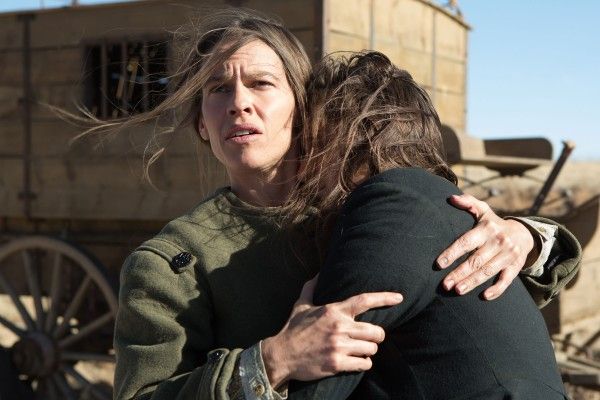Tommy Lee Jones’ latest directorial effort, The Homesman, is a moving portrait of the harsh unpredictability of pioneer life in the mid-19th century American West told from the viewpoint of a resilient, resourceful woman. The harrowing tale is based on Glendon Swarthout’s award-winning novel about Mary Bee Cuddy (Hilary Swank), an intrepid frontierswoman who convinces a low-life drifter (Jones) to accompany her on an arduous journey transporting three ill women across the Nebraska Territories to Iowa. Opening November 14th, the film features an impressive supporting cast that includes John Lithgow, Hailee Steinfeld, James Spader and Meryl Streep.
At the film’s recent press day, Jones and Swank spoke about playing characters with so many layers of emotions, how they captured the authenticity of an era, why the film is not just a period piece but also parallels everyday life for a lot of people, the qualities of strength, vulnerability and relatability that Mary Bee possessed which appealed to Swank, working with Jones as both an actor and a director and the shorthand they developed on set, how Jones’ experience as an actor informs his work as a writer and director, Swanks’ singing scenes, and shooting on location in New Mexico and Georgia. Check out our interview after the jump.
Question: This is a beautiful and captivating film. The cinematography that you and D.P. Rodrigo Prieto have created is a story unto itself. What were your considerations in terms of the film’s tone and visual design?
TOMMY LEE JONES: Well, it’s a journey eastward, and the destination looked a lot different than the origin. I got really tired of trying to figure out how we were going to make Galisteo, New Mexico look like bosky woods. We thought of everything and all manner of computer-generated imaging and phony trees and it just didn’t work. We were very lucky to find Lumpkin, Georgia where some man with a considerable amount of discretionary income tried to buy every 19th century house in Georgia and Alabama, and he brought it and made it a little town and it was perfectly suited to our purposes. We were very, very lucky to find that facility. Because of the contrast between Nebraska and Iowa, we wanted the end of the journey to look and feel a lot different than the beginning. It was pretty simple.
Mr. Jones, what were the elements of this story that really affected you and motivated you to devote so much creativity and time to making this happen? Also, how easy was it to zero in on Hilary as clearly the right actress to play this role?
JONES: The book offered us a chance to make a screenplay that had some originality to it, and of course, our lives as filmmakers are a never ending search for originality. We are desperately clawing for originality. It’s not always readily available. We worried about Hilary for probably two or three seconds after we met. We met at an Italian restaurant here in Beverly Hills. It was immediately obvious to me and to Michael Fitzgerald that Hilary was absolutely perfect. Of course, I’ve seen all of her films before meeting her. I knew immediately that if we could talk her into playing Mary Bee Cuddy, half our job would be done.
HILARY SWANK: I actually read the script and I emailed Tommy Lee. Then he sat down with me, so there was no talking me into it. It would be nice if it was just like that all the time.
JONES: Yeah. It would.
My family settled in Nebraska and Iowa in the 1860’s and I’m amazed at the realistic texture and tone of the film which reminds me of family photos I have from that era. How did you achieve that level of authenticity?
JONES: To answer that as simply as possible, the first thing I should mention is an itinerant photographer who traveled around Nebraska in the mid-19th century making his living taking photographs of people and their houses. He had a motif usually. He had a pretty wide lens and he would feature one hundred percent of the house, which is very useful to us in providing the architectural details when we began to build these houses ourselves. These people lived very isolated lives and photography wasn’t a part of their life. If they had a chance to get their picture taken, it was a big deal. The whole family would come out. We saw a lot of these pictures. The whole family would get out in front of the house with their best clothes on, and if they had a good crop of watermelons that year, they’d put out a table and they’d put the watermelon on the table. They’d cut the watermelon in half. If they had a piano or a melodeon, they’d bring it out of the house and get that into the picture. Granddad would be in the middle, and they’d all be there posing with their guns, and anything they were proud of they’d be sure to get it into the picture. It’s a wonderful record of the costumes, the hair and makeup which was very useful to us.
SWANK: I just want to add to this my aunt, funny enough who is sitting right behind you, and my family over here, they’re from Iowa. I was born in Nebraska. I come from a generation of farmers, too. And what’s interesting, I want to tell you this, is my dad gave me accounts of our history. Our family goes to the early 1700’s in Iowa as well and there is one account that is so shockingly similar to the story, but I only read it three days ago, that my jaw dropped. My dad is here to see the premiere and he doesn’t know what the movie is about. I just thought, wow, I couldn’t wait to tell you that. It is astounding. One of the things was Indians shot one of my ancestors, John Swank, 19 times, but he was against a rock. He stayed upright, and they fled because they thought he was a spirit when he didn’t fall over. It was really interesting.
Hilary, you play a woman who’s not just emotionally strong but physically strong. I didn’t realize it was so difficult to get the water out of the well. What kind of an emotional or physical toll does it take on you to play such a character?
SWANK: That was a fake well. Tommy Lee said, “You have to make this look difficult.” That’s why I made such a fuss. He goes, “When you pump this, there’s nothing to it. Make it look like there’s something to it.” That’s cool. I would say that the things that Mary Bee was working through are not dissimilar to the things we all work through in our lives. I mean, we all struggle to find how to be the best people we can be and try to find love along the way. And that’s why to me it’s not just a period piece. It really parallels everyday life for a lot of people. I relish the opportunity that I get to play these real slices of life, because even though it’s not based on a true story, it really in a lot of ways is an account of my family’s history. It’s real life. It’s real life stuff. And getting to do it alongside someone as esteemed as Tommy Lee who’s been doing it for so long is such an honor as an artist. To me, Mary Bee is a woman who has manners and morals and values, and she wants to do the right thing just for the sake of doing the right thing. In my opinion, we have really lost touch with that as a society today. So, there are so many reasons why I love her, and then there are so many reasons why I relate to her just getting into touching on what you were talking about, because as an independent woman myself, as a woman who for all intents and purposes people will probably call bossy, I have a real clear idea of how I see the world and how I want to live the world, and I want to see my dreams realized. I want to continue down my path. And so, finding a man to walk shoulder to shoulder with me can be challenging. I think women today have that challenge. There are a lot of reasons why I love her and the vulnerability of her and her strengths.
Can you talk about working with Tommy Lee as both an actor and as a director?
SWANK: I’m not just saying this because he is here. He’s truly extraordinary. Tommy Lee comes alive in a different way when he’s in that element of doing what he loves. For me, it’s hard enough to figure out my character, let alone wear all the hats that he wore as the co-writer, as the director, and the actor, and to just be as together as he was in being at the helm of all of those things. I have to honestly tell you that I didn’t want this to be over. I wanted it to continue going on. I even made a joke saying TV is not my medium, only because I like to play a character and then let it go and find the next character. I don’t know how I would do playing a character year after year. But if this could have gone into TV series, I would have been really happy, because I really enjoyed it at every level as an artist, and all the things that I was able to sponge up from this veteran, and just being under his guidance. Also, when you work with your director who is also acting with you, there’s a shorthand. He knows how to say something in a few words to get the point across.
Mr. Jones, how do you feel your experience as an actor prepared you and informs your work as a writer and director?
JONES: My education as a filmmaker has been entirely practical. I started working professionally in the film business in 1970, and I’ve been at it steadily since and I pay a lot of attention. I’ve worked with some very good directors and some very bad ones. I learned a great deal from both. From the bad, untalented people, you learn what not to do. And when you work with very highly talented people, you want to emulate them. So, as I said, my education has been practical or on the job training. Every day is a bigger, broader, brighter day than the day before.
What did you learn from your last experience as a director that you were able to bring onto this film?
JONES: It gets easier to budget my time hour by hour. I suppose that’s a learning process.
SWANK: He learned not to give me a horse between takes because I’d…
JONES: She’d leave.
SWANK: They had a horse wrangler, but it became the Hilary wrangler.
JONES: She got better, but she didn’t know a lot about riding horses or driving a team of mules or plowing with a double shovel. But she worked at it until she was able to make a very convincing picture of all of those. Between takes [she’d leave], or when we had what we called a turnaround and you’re shooting this way, and it takes a little while to turn the camera and look the other way because everything that’s back here has to move.
SWANK: I was like, “Yee haw!”
JONES: There she would go. It got to the point where I’d have to send a wrangler with her with a radio on his belt to make sure she didn’t fall off in an arroyo somewhere or a gully or little canyon, or have a wreck, or just not know when to come back.
So you learned to keep Hilary Swank on a short leash?
JONES: No, I turned her completely loose, but I sent somebody with a radio. (Laughter)
Hilary, your character has such a defining moment in the film. I’m wondering when you read the novel and the script, did that change your opinion of her? Did that affect the way you approached playing her?
SWANK: It made me realize just how truly human she was and how vulnerable she is. All the things I’ve been talking about, I say she goes where angels fear to tread. All these valiant attributes to her, there’s still an underlying need for love. She’s human. To me, it made me realize I loved her even more, not because of the choices she made, but because it was relatable that kind of fear and what could happen to us.
Tommy Lee, there are several scenes where Mary Bee is singing beautifully. Was that a factor in casting who would play her? Did you know that Hilary could sing?
SWANK: (Laughs) That was a stunt in my opinion.
I don’t think many people knew that you could sing like that.
SWANK: I didn’t know it either.
Did you audition her to make sure she could sing before you cast her?
JONES: No. The important thing is Mary Bee’s loneliness and her hunger for some kind of culture. There’s a very telling moment in the early part of the movie when she’s playing this scene so beautifully with John Lithgow. She looks out the window through this beautiful light and in a more or less abstracted way says, “I don’t think I can live much longer without real music.” And that becomes telling. That’s more important. We didn’t have any musical auditions. The important thing was Hilary’s sensitivity to all the nuances of Mary Bee’s character.
When you filmed those singing scenes, there were various different shots and angles that were cut together seamlessly while she was singing live. Did you edit them when there was a pause in the phrasing of the song? How did you do that?
SWANK: Actually Tommy Lee didn’t want to cut a line. He said, “I’m not going to cut around this. I’ll do two different set-ups of this, but I really want it to be pretty much all in one. It made me even more nervous. He just said, “If it doesn’t work, it doesn’t work. Then it won’t necessarily be the whole thing in the movie. I’d like the whole song, but if it can’t be the whole song and you only get a quarter of it, then it’s going to be a quarter of it.” (to Tommy Lee) Do you remember saying that?
JONES: Oh yeah.
SWANK: That was like the third day of filming so I was still fresh and I was still trying to figure everything out. I take obviously great pride in the opportunities I get and I don’t want to let my director down, so I tried my hardest. I didn’t know what it was going to sound like or how it was going to work, but I just trusted in him that it would somehow.
JONES: I think you sang that song six times to get that scene. The essential thing about that scene was a dolly track that moved 180 degrees from this profile to head on to that profile. You do that in two different sizes – medium and close – going both directions. And then you lock off. Over there it was eight times. We got two different sizes there and one from over here.
SWANK: You ended up with something great up here in that ceiling shot.
JONES: That’s what saved us from editing. It was that thorough shooting. Originally, there were three verses to that song, but the movie doesn’t have time to stop and listen to all three of them. So it was edited to about one-third of its original length -- one verse and part of a chorus. It’s a beautiful scene. But what makes it work is really that 180 degree dolly track and the camera is always moving. There is always something happening. As the camera moves, that candle gets behind her head and backlights her hair beautifully.
In those close-ups where you knew there was supposedly a fire or a slow-burning candle, how did you achieve that flicker effect on everyone’s face?
JONES: We used candles. If you’re moving this camera around and suddenly a candle that you see originally here winds up being an angelic backlight. It makes a halo. That was the trick I was trying to play. It looks static but it’s always moving. You can’t take your eyes off of her in that singing scene.
Is it a different challenge for you to direct the actors and actresses who do a lot of talking compared to the three women who hardly talk at all in the film? Did you have to come at that with a different approach?
JONES: No, sir. Talking is just one of the things that actors do. Movement is another one. There are a lot of moving parts to the job of acting, but really directing somebody who doesn’t talk as opposed to somebody who does is not a lot of difference.
It was no more of a challenge to get what you wanted out of them when they’re not speaking?
JONES: No, sir. No. What you want is to get the feelings right. Sometimes words help. Sometimes they don’t.
SWANK: Yeah. Most of the time you’re trying to figure out what’s happening between the lines, because that’s really the reality, other than what you’re saying, in fact.
Is there symbolism to what happens on the ferry?
JONES: That image is based on a painting by George Caleb Bingham. If you learn about his painting, then you’ll see we did our best to defile it. (Laughs)
Tommy Lee, you’re famous in Japan for playing Alien Jones in commercials for BOSS coffee and you’re very funny in the TV ad. Which is easier for you to play? A super funny character or a very serious one like you do in this film?
JONES: You’re mentioning some kind of dichotomy that I don’t recognize. I really love doing those commercials in Japan. I’m leaving in three weeks to make some new ones. It’s the most successful advertising campaign in the history of Japanese advertising.
SWANK: Wow, that’s cool! Congratulations.
JONES: People love it.
SWANK: I think she wanted to know, is it easier to be funny in those or to be serious in something like this.
JONES: Well comedy is deadly serious business. It’s very dangerous. It’s scary.
SWANK: It’s true.
JONES: So, I don’t know. I love being an actor. I’m always happy to have a job.
SWANK: I think what’s great is that he can do both and that it defies stereotypes because certainly when people talk to me about Tommy Lee, they’re like, “He’s so serious and intense.” Yet, maybe that’s what he wants to portray at that moment. You don’t have to show all facets of yourself at one time. That’s the great thing about being an actor is we get to share all different sides of us that we have in us. But I don’t think everyone can show all those sides, and so it just speaks to his talent to be able to do all different types of genres and do it so well.
JONES: Hilary, I want you to go with me for the rest of this [press tour], because only you could both ask and then answer the question. (Laughs)
SWANK: Deal! Done!
JONES: I’m sticking with you.

